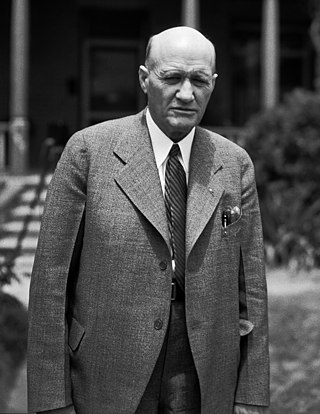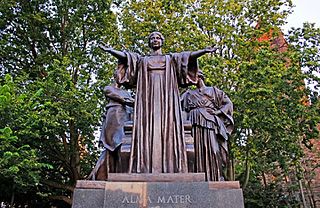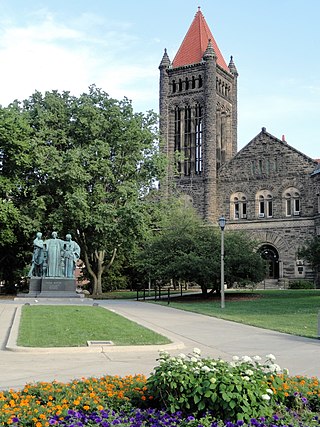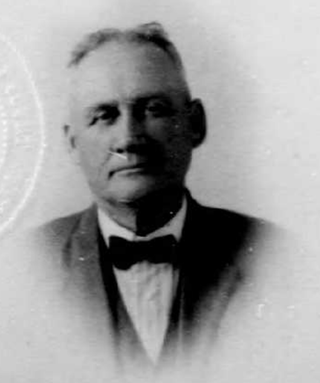
St. Lawrence University is a private liberal arts college in the village of Canton in St. Lawrence County, New York. It has roughly 2,400 undergraduate and 100 graduate students.

Tennessee Technological University, commonly referred to as Tennessee Tech, is a public research university in Cookeville, Tennessee. It was formerly known as Tennessee Polytechnic Institute, and before that as University of Dixie, the name under which it was founded as a private institution. Affiliated with the Tennessee Board of Regents, the university is governed by a board of trustees. It is classified among "R2: Doctoral Universities – High research activity".

Benjamin Baker Moeur was an American physician who served as the fourth governor of Arizona.
Arizona State University at the West Campus is a public university in Phoenix, Arizona. It is one of five university campuses that compose Arizona State University (ASU). The West campus was established by the Arizona Legislature in 1984, and is located in northwest Phoenix, bordering the city of Glendale.

Glynn Academy (GA) is an American public high school in Brunswick, Georgia, United States, enrolling 1,900 students in grades 9–12. Along with Brunswick High School, it is one of two high schools in the Glynn County School System. Glynn Academy offers technical, academic, and Advanced Placement programs and is accredited by the Georgia Department of Education and the Southern Association of Colleges and Schools. The school has consistently been ranked among the top public high schools in the United States by Newsweek.
The main campus of Virginia Tech is located in Blacksburg, Virginia; the central campus is roughly bordered by Prices Fork Road to the northwest, Plantation Road to the west, Main Street to the east, and U.S. Route 460 bypass to the south, although it also has several thousand acres beyond the central campus. The Virginia Tech campus consists of 130 buildings on approximately 2,600 acres (11 km2). It was the site of the Draper's Meadow massacre in 1755 during the French and Indian War.

The University of Illinois Urbana-Champaign is an academic research institution located in Urbana, Illinois and the flagship campus of the University of Illinois System. Since its founding in 1867, it has resided and expanded between the twin cities of Champaign and Urbana.

David R. Francis Quadrangle is the historical center of the University of Missouri in Columbia, Missouri. Known as The Quad, it is the oldest part of Red Campus and adjacent to Downtown Columbia at the south end of the Avenue of the Columns. At its center are six Ionic columns, all that remains of the original university building Academic Hall. Twelve buildings front the modern quadrangle including the domed main administration building Jesse Hall, the tallest building in Columbia. The Quad was designed and constructed by architect Morris Frederick Bell and his assistant William Lincoln Garver. It is named after Missouri governor David R. Francis. Eighteen structures, including the entire quad and most of Red Campus are listed as the Francis Quadrangle National Historic District. An obelisk, the original tombstone of Thomas Jefferson, stands in front of the Chancellor's Residence. It was gifted to the University by Jefferson's descendants in recognition of Missouri's ties to Virginia. In front of Jesse Hall stand markers honoring university president Richard Henry Jesse and Missouri governor David R. Francis. Nearby is another obelisk in memory of Missouri's first U.S. senator David Barton, The Missouri School of Journalism is located at the northeast corner of The Quad, comprising Walter Williams Hall, Neff Hall, Gannet Hall, along with the Reynolds Journalism Institute. To the west, Switzler Hall is the oldest academic building on campus, though the Residence on the Quad, home of the chancellor, is the oldest building overall. The University of Missouri College of Engineering completes the west side. Pickard Hall is currently closed due to radiation contamination from turn of the century experiments. Swallow Hall was recently renovated and houses the Departments of Anthropology, Visual Studies and Ancient Mediterranean Studies.

Old Main, at 400 East Tyler Mall on the Tempe campus of Arizona State University, is the oldest building on the campus. It was built in 1898 and was designed by W. A. McGinnis in the Victorian Queen Anne style with Richardsonian Romanesque influences. Along with the Administration/Science Building and a third building no longer extant, Old Main defined the first quad on the campus of the Arizona Territorial Normal School; Arizona would not become a state for 14 years after Old Main was dedicated.

East Campus is a collection of buildings and facilities situated on the 60-acre (240,000 m2) hilltop campus that is the original site of Western Michigan University. It includes some of WMU's athletic facilities including Waldo Stadium, Hyames Field, Ebert Field and the Donald Seelye Athletic Center. The campus sits on the top of Prospect Hill, which overlooks the city of Kalamazoo, Michigan.

"Altgeld's castles" are buildings in the Gothic Revival style in five Illinois universities, all built at the initiative or inspiration of Illinois Governor John Peter Altgeld. During his term as governor, Altgeld expressed certain opinions on how buildings should be erected in the state of Illinois. In his second biennial message to the state legislature, he discussed how buildings were being constructed without consideration for their outward appearance. He stated that it was time for buildings to become more aesthetically pleasing in addition to being functional, and he suggested the "Tudor-Gothic style" as the most inexpensive way to do this. Consequently, several of the state universities in Illinois erected buildings which resembled castles in his honor. College folklore states that these buildings have aligned corridors and rooms so that they could all be "put together" to create one large building, but there is no evidence to support this rumor.
Arizona State University Tempe campus is the main campus of Arizona State University, and the largest of the five campuses that comprise the university. The campus lies in the heart of Tempe, Arizona, about eight miles (13 km) east of downtown Phoenix. The campus is considered urban, and is approximately 642 acres (2.6 km2) in size. The campus is arranged around broad pedestrian malls and, in toto, is considered to be an arboretum. ASU has an extensive public art collection, considered one of the ten best among university public art collections in the United States. Against the northwest edge of campus is the Mill Avenue district which has a college atmosphere that attracts many students to its restaurants and bars. ASU's Tempe Campus is also home to all of the university's athletic facilities.
The University of Arkansas Campus Historic District is a historic district that was listed on the National Register of Historic Places on September 23, 2009. The district covers the historic core of the University of Arkansas campus, including 25 buildings.

The Ohio State Normal College at Kent is a historic district in Kent, Ohio, United States. It consists of the five original buildings on the main campus of Kent State University, with the first, Merrill Hall, opening in 1913 and the last, Moulton Hall, opening in 1917. It was added to the National Register of Historic Places in 1975. The name of the district comes from the working name of what would later be named the Kent State Normal School in 1911 and ultimately Kent State University by 1935.

West Hall, built in 1917, is the oldest building at Valdosta State University and features a distinctive dome and Spanish-mission architecture. It is also the center of academic activity at VSU, with numerous classrooms, departments, and offices. West Hall is named in honor of Colonel W.S. West, who as a Georgia state senator, led the legislation for the creation of a college in Valdosta through the Georgia Senate and donated the property that is now the main part of campus to the state for use by the new institution.

Kemper Goodwin was a noted architect from Tempe, Arizona. He specialized in educational buildings. Some of his buildings are listed on the National Register of Historic Places in Arizona.

James Miller Creighton was an American architect who practiced in Phoenix, Arizona from the 1880s to the 1920s. He is considered to be one of Arizona's first architects.
The Minnesota State University campus currently contains 30 buildings spread over 303 acres (123 ha) in Mankato, Minnesota, United States. The campus includes on campus housing in the form of dorms for 2,700 residents, academic buildings, a main library, a music library, two astronomy observatories, experimental research stations for alternative and renewable energy, a recreation center, an athletics complex, a student center, an administration center and over 50 acres of athletics fields including the football team Blakeslee Stadium. The Minnesota State Mavericks men's and women's hockey teams also utilize and have administrative space at the Verizon Wireless Center and the All Seasons Arena located off campus.

















